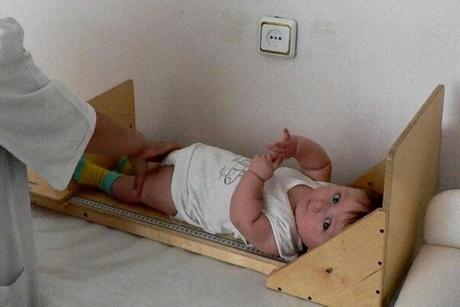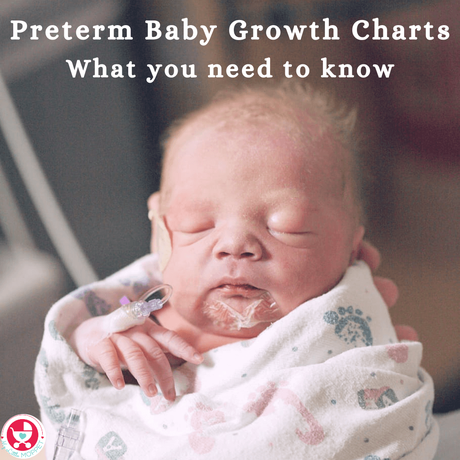February 23, 2022 Leave a Comment
A preterm baby’s growth needs to plotted in a way different from that of full term babies. Here’s everything you need to know about it.
For all parents, tracking the growth of their new baby and taking note of milestones is something that they look forward to, as we enjoy watching them grow before our eyes. However, for parents of preterm babies, this is accompanied by a great deal of anxiety and confusion.
There are many reasons for this. Preterm babies are at a greater risk for developmental delays since they miss out on the valuable final weeks of gestation. This of course, depends on how premature the baby was born, as earlier births indicate greater risks.


Due to this, it is important to keep an eye on baby’s growth, and growth charts are the best way to do it. The doctor will of course, check the baby’s important growth markers at every visit, but it is helpful for parents to keep their own notes too. Any discrepancy or cause for worry can be brought to the doctor’s notice immediately, and as with everything, earlier detection means better chance of recovery. Here is a look at the most commonly used preterm baby growth charts and what you need to know about them.
A Guide to Preterm Baby Growth Charts

Baby growth charts generally contain information about three main parameters – weight, length and head circumference. These are the most important measurements to take for preterm babies to ensure they are growing. These are usually measured first within 12 hours of birth and then after every 2 weeks for the first 2 months, and then every 4 weeks for the next 6 months.
You are likely to come across these terms – chronological age and adjusted or corrected age. Chronological age is also known as absolute age or postnatal age and is the time from the birth of the preterm baby to the present day. Adjusted age or corrected age will be explained further below.
Another term that parents need to familiarize themselves with is ‘percentile‘. A child’s growth pattern is generally analyzed in terms of percentiles. It indicates what percent of the overall population the baby is a part of. For example, if a one year old girl’s weight is in the 90th percentile, it means that she weighs approximately the same as or more than 90% of other one year old girls. It also means that she weighs less than 10% of girls her age.
A baby’s weight or length percentile mostly remains the same as she grows older, probably going up or down by 1 percentile. A healthy baby should ideally have similar percentiles for their height (length) and weight. If not, it means that the baby is either overweight or underweight.
Let’s take a look at the most commonly used preterm baby growth charts. Please note that boys and girls have separate charts since boys are generally heavier than girls.
Fenton Growth Charts

The American College of Obstetricians and Gynecologists (ACOG) defines any baby born before 37 weeks of gestation as a preterm baby. There are various levels of prematurity depending upon how many weeks earlier the baby was born. For all preterm babies, using regular growth charts as for term infants will not give us the right information, which is why we use special preterm baby growth charts, like the Fenton growth charts.
The Fenton charts were created by Dr. Tannis Fenton, a Professor at the University of Calgary. The charts were created in 2003 and were later revised in 2013 to accommodate the latest WHO standards. These charts are used widely by medical professionals and organizations across the world, like the American Academy of Pediatrics, the Merck Manual, the Spanish Society of Gastroenterology and Paediatric Nutrition, the Ecuador Ministry of Public Health as well as the Pediatric Societies of France, Turkey, Portugal and Colombia.
Fenton growth charts are specially designed for preterm babies born from 22 weeks of gestation onwards. They contain information regarding weight, length and head circumference and include the 3rd, 10th, 50th, 90th and 97th percentiles. The information is available in weekly increments, so you can track your baby’s growth every week. As with regular growth charts, there are separate charts for boys and girls.
Here is a table that gives a summary of the Fenton growth charts for girls. You can download the full chart here.
Gestational Age Weight Height Head Circumference
24 weeks 0.6 kg 30 cm 21.1 cm
26 weeks 0.8 kg 33 cm 23 cm
28 weeks 1 kg 35.6 cm 25 cm
30 weeks 1.3 kg 38.5 cm 27 cm
32 weeks 1.7 kg 41.1 cm 29 cm
34 weeks 2.1 kg 44 cm 30.5 cm
36 weeks 2.6 kg 46.5 cm 32.1 cm
38 weeks 3.1 kg 48.5 cm 33.5 cm
40 weeks 3.4 kg 50.5 cm 34.9 cm
Here is a table that gives a summary of the Fenton growth charts for boys. You can download the full chart here.
Gestational Age Weight Height Head Circumference
24 weeks 0.65 kg 31 cm 22 cm
26 weeks 0.83 kg 34 cm 23.5 cm
28 weeks 1.1 kg 36.5 cm 25.8 cm
30 weeks 1.4 kg 39 cm 27.5 cm
32 weeks 1.8 kg 42 cm 29.5 cm
34 weeks 2.25 kg 44.9 cm 31 cm
36 weeks 2.7 kg 47 cm 32.8 cm
38 weeks 3.2 kg 49.5 cm 34 cm
40 weeks 3.6 kg 51 cm 35 cm
It is recommended that once the baby has crossed 40 weeks of chronological age, the Fenton charts be used alongside regular charts for full term babies. Besides the Fenton charts, there are other preterm baby growth charts like the Intergrowth21 charts and Babson and Benda charts, although they’re not as popular as the Fenton versions.
WHO Growth Charts

The WHO growth charts are recommended for full term babies and track growth stats from birth to 2 years of age. These charts also include information about weight, length and head circumference. Like the Fenton charts, there are separate charts for boys and girls. However, unlike the Fenton growth charts which show weekly increments, the WHO growth charts show information in monthly increments. This is probably due to the fact that preterm babies need more frequent monitoring than full term babies.
Although the WHO growth charts are recommended for full term babies, they can be used for preterm babies too. However, in this case, the baby’s adjusted age will have to be used as the criteria for tracking growth, rather than the baby’s actual age. Adjusted age or corrected age is the age the baby would have been if born on the original due date. Here is a simple formula to calculate your baby’s adjusted age.
X – Your baby’s actual age in weeks (the number of weeks since the date of birth)
Y – Number of weeks your baby was born early (how many weeks early your baby was born from the original due date OR 40 weeks minus gestational age at birth)
Once you’ve determined X and Y, you can apply them here:
Adjusted/Corrected Age = X – Y
Here are some examples of adjusted age for different chronological ages:
Actual/ Chronological Age Weeks Born Early Adjusted/ Corrected Age
24 weeks 7 weeks 17 weeks
30 weeks 5 weeks 25 weeks
34 weeks 3 weeks 31 weeks
While preterm babies are considered to be those born before 37 weeks, the different stages of prematurity means that there are different guidelines for using these growth charts, like these:
- Babies born after 36 weeks and 6 days are considered full term and don’t need to be adjusted for age
- Babies born 32-36 weeks can use the adjusted age up to 1 year and the regular growth charts thereafter
- Babies born before 32 weeks will have to use the adjusted age up to 2 years
The reason there is a difference in how long the adjusted age is to be used for tracking growth is because of catch up. This is the time a premature baby may take to catch up to full term babies of the same chronological age. This usually happens by 2 years of age. In cases where babies are having trouble catching up, doctors may recommend using the adjusted age till 3 years.
Tracking Weight for a Preterm Baby

The final trimester is when the fetus puts on fat and grows in weight, which enables it to survive once out in the world. It is this valuable period that the preterm baby misses out on, which is why weight tracking is important. Based on birth weight, babies are classified into different groups:
- Low birth weight (LBW) – Birth weight < 2.5 kg
- Very low birth weight (VLBW) : Birth weight < 1.5 kg
- Extremely low birth weight (ELBW) : Birth weight < 1 kg
In general, the lower the birth weight, the greater the chances of developmental problems. Most issues seem to occur in babies weighing under 1.5 kg, many of whom are born before 32 weeks of gestation. A combination of factors like low birth weight and early birth can cause serious issues like respiratory trouble, pulmonary and circulatory problems and necrotizing enterocolitis, among others.
However, most preterm babies who weigh less than 1 kg at birth gain weight quickly, doubling their birth weight by 10 weeks and tripling it by 18 weeks. Experts say that a daily gain of 15 grams for every kilogram of body weight is ideal, and is the average rate of growth of a fetus in the third trimester inside the womb.
Some hospitals have guidelines on how much a baby must weigh so that it can be discharged from the NICU or can be taken home. In most institutions, meeting the following criteria means the baby is ready to go home:
- Reaching 34 weeks of gestation or a body weight of 2 kg
- Gaining at least 20-30 g per day
- Being able to feed by mouth
- Stable body temperature when the baby is in an open crib
- Not requiring any medication or oxygen
Tracking Height for a Preterm Baby

While the height or length of babies is generally not given as much importance as the weight during early tracking, it is still an important parameter particularly for preterm babies. Full term babies grow about 1.5-2.5 cm every month till 6 months, but preterm babies grow faster, and it follows this pattern:
- 1.1 cm every week till they reach 40 weeks of gestation
- 0.75 cm per week for the next 3 months
- 0.5 cm per week after that
Like weight, the height of preterm babies depends upon their stage of prematurity, and very premature babies are more likely to be shorter. Some children catch up during adolescence, while some may remain short throughout life. Genetics plays a role, and children with parents or family members who are short are also likely to follow suit.
Tracking Head Circumference for a Preterm Baby

Along with weight and height, preterm baby growth charts include another important measurement – head circumference. This measurement is usually done with a soft measuring tape around the largest area of the head, usually above the eyebrows. Generally boys have larger heads than girls. The head is measured to identify if the baby’s brain is developing normally or if there could be a problem. The expected rate of head growth is 0.5 cm per week until 3 months of age and 0.25 cm per week thereafter. Studies have shown that preterm babies who were fed breast milk had better head circumference growth.
If the weekly increase in head circumference is more than 1.25 cm, there is a possibility of hydrocephalus, or water in the brain. If the head growth is too less, it could be due to microcephaly, which could lead to loss of vision or hearing, seizures and developmental delays. However, over 70% of children born with microcephaly overcome it by the age of 2 years. Children who continue to have microcephaly after 24 months are likely to have poor cognitive development or issues like cerebral palsy.
Catching Up

Although premature babies miss out on developmental time inside the womb and seem to be behind their full term peers in the beginning, most babies catch up with 2 years in terms of weight, length and head circumference. During this 2 year period, preterm babies grow at a faster rate than full term babies, which enables them to catch up effectively. A baby is considered to be catching up when she reaches between the 5th to 10th percentile on the growth chart.
The first signs of catch up growth can be seen in the head circumference, then in the weight and height. This is a sign that the baby is growing well. The fastest catching up happens between 36-40 weeks of gestational age, and slows down after that. However, the rate of catch up depends on many factors like the stage of prematurity, based on these guidelines:
- 34-37 weeks – Late preterm
- 32-34 weeks – Moderately preterm
- 25-32 weeks – Very preterm
- Less than 25 – Extremely preterm
As can be expected, late preterm babies catch up faster than very or extremely preterm babies, who may also have to deal with other medical issues. Other factors may also slow down the rate of catch up, like congenital defects or staged feeding plans used by certain hospitals to prevent gut infections in preterm babies. While most preterm babies catch up by the age of 2 years, some children may continue catching up till 5-7 years. A few children may have a sudden catchup phase during adolescence.
Apps and Calculators

Since the tracking of preterm baby growth can be a little tricky at times, it helps to use technology that is designed for the purpose. The AnthroCalc app for Android calculates percentiles for length, weight and head circumference of preterm babies using the Fenton charts. It can also predict the child’s adult height or growth rate.
The Preterm Growth Tracker app for iOS also uses the Fenton growth charts and has been designed in collaboration with Dr. Tannis Fenton. The app can track the growth of babies from 20 weeks to 37 weeks and can also enable printing the complete chart for your reference.
Besides phone apps, you can also use PediTools, a website tool that lets you enter all your baby’s information to find out if she’s growing well or what percentile she’s in with regards to height, weight and head circumference.
It is important to remember that while every baby grows at his or her own rate, tracking growth can be trickier with a preterm baby since there are many more factors that come into play. Don’t compare your preterm baby’s development with a full term baby’s or even another preterm baby’s. By monitoring your baby’s growth closely, you will be able to identify any potential problems and get them corrected at the earliest.
References
- Monitoring the Postnatal Growth of Preterm Infants: A Paradigm Change, American Academy of Pediatrics
- Fenton Preterm Growth Charts, University of Calgary
- Plotting Preterm Infants, UK Royal College of Pediatrics and Child Health
- Care of the Premature Infant: Part I. Monitoring Growth and Development, American Family Physician
- NICU Family Information Packet, Agency of Healthcare Research and Quality, U.S. Dept. of Human Health & Services
- CDC Growth Charts, Centers for Disease Control and Prevention
- Head Growth and Intelligence from Birth to Adulthood in Very Preterm and Term Born Individuals, Journal of the International Neuropsychological Society
- Head Growth and Intelligence from Birth to Adulthood in Very Preterm and Term Born Individuals, Journal of the International Neuropsychological Society

Buy Healthy Nutritious Baby, Toddler food made by our own Doctor Mom !
Shop now!You may also like
- Free Monthly Food Chart for Babies Toddlers delivered by…

- Standard Height and Weight Chart for Babies that every…

- Helping your Premature Baby Gain Weight

- Contact Us

- Causes of Premature Birth and Preventive Measures

- How to Sterilize Baby Feeding Equipment and Utensils

Filed Under: Baby, Baby health, Growth and Weight Tagged With: caring for a preemie, caring for a premature baby, growth chart, how to care for a preemie, how to care for a premature baby, how to care for a preterm baby, preemie, premature baby, preterm baby
